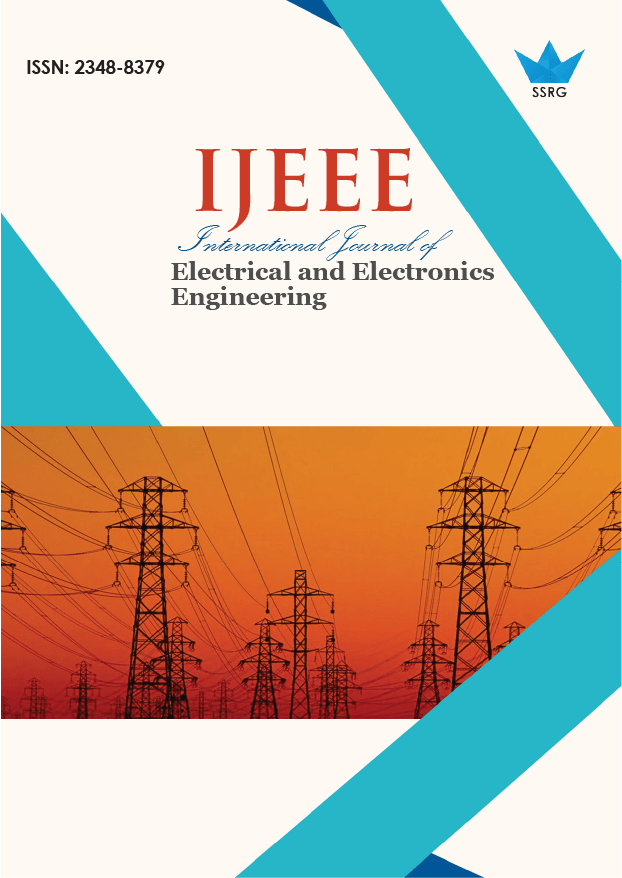Five Finger Rake Receiver Performance Analysis for Odd/Even Parity Maximal Spreading Code

| International Journal of Electrical and Electronics Engineering |
| © 2024 by SSRG - IJEEE Journal |
| Volume 11 Issue 12 |
| Year of Publication : 2024 |
| Authors : M. Dileep Reddy, G. Sreenivasulu |
How to Cite?
M. Dileep Reddy, G. Sreenivasulu, "Five Finger Rake Receiver Performance Analysis for Odd/Even Parity Maximal Spreading Code," SSRG International Journal of Electrical and Electronics Engineering, vol. 11, no. 12, pp. 144-149, 2024. Crossref, https://doi.org/10.14445/23488379/IJEEE-V11I12P113
Abstract:
The main complication in wireless systems is multipath fading. There is substantial damage in the mobile unit that receives signals due to multipath fading. The received signal deterioration is very high if the multipath path delay is lower than the chip duration. Rake receiver mitigates multipath fading phenomenon. Rake receiver combines different incoming signals by a large quantity of ‘sub receivers’ called as ‘fingers’. The multipath diversity principle is used in this receiver arrangement. Rake calculates the power from numerous transmitted signals. This paper presents the Bit error probability for Rake receiver using Odd parity or parity maximal codes for data spreading in the transmitter, considering mobile slow and flat fading channels. Performance Analysis of Rake receiver is publicized by applying MATLAB®.
Keywords:
Rake receiver, Multipath, Signal to Noise Ratio, Code matched filter, Parity bits.
References:
[1] D. Sri Kavya, and P. Siddaiah, “Implementation of Seven Finger RAKE Receiver Using MRC Technique,” International Journal of Recent Technology and Engineering (IJRTE), vol. 8, no. 3, pp. 1689-1693, 2019.
[CrossRef] [Google Scholar] [Publisher Link]
[2] I.A. Alimi, J.J. Popoola, and K.F. Akingbade, “A Power Efficient Rake Receiver for Interference Reduction in the Mobile Communication Systems,” International Journal of Electronics and Electrical Engineering, vol. 3, no. 6, pp. 501-505, 2015.
[CrossRef] [Google Scholar] [Publisher Link]
[3] Vaibhav Khairanr, Jitendra Mathur, and Hema Singh et al., “Bit Error Rate Performance Analysis of CDMA Rake Receiver,” International Journal of Engineering Science Invention, vol. 3, no. 6, pp. 52-58, 2014.
[Google Scholar] [Publisher Link]
[4] Busim Ananta Lakshmi et al., “Design and Analysis of Rake Receiver,” 2023 International Conference on Sustainable Computing and Data Communication Systems (ICSCDS), Erode, India, pp. 1020-1027, 2023.
[CrossRef] [Google Scholar] [Publisher Link]
[5] Kyungwhoon Cheun, “Performance of Direct-Sequence Spread-Spectrum RAKE Receivers with Random Spreading Sequences,” IEEE Transactions on Communications, vol. 45, no. 9, pp. 1130-1143, 1997.
[CrossRef] [Google Scholar] [Publisher Link]
[6] U. Grob et al., “Microcellular Direct-Sequence Spread-Spectrum Radio System Using N-Path RAKE Receiver,” IEEE Journal of Selected Areas in Communications, vol 8, no. 5, pp. 772-780, 1990.
[CrossRef] [Google Scholar] [Publisher Link]
[7] Babak Hossein Khalaj, Arogyaswami Paulraj, and Thomas Kailath, “2D Rake Receivers for CDMA Cellular Systems,” 1994 IEEE GLOBECOM. Communications: The Global Bridge, San Francisco, CA, USA, 1994.
[CrossRef] [Google Scholar] [Publisher Link]
[8] Xinyue Li, Yajie Yan, and Deyue Zou “A Master-Slave Rake Receiver for Integrated Navigation/ Communication Signal,” 2021 International Wireless Communications and Mobile Computing (IWCMC), Harbin City, China, pp. 1070-1074, 2021.
[CrossRef] [Google Scholar] [Publisher Link]
[9] V. Umadevi, and P. Easwaran “ A Study on Rake Receivers,” 2017 IEEE International Conference on Electrical, Instrumentation and Communication Engineering (ICEICE), Karur, India, pp. 1-5, 2017.
[CrossRef] [Google Scholar] [Publisher Link]
[10] S. Popa, N. Draghiciu, and R. Reiz, “Fading Types in a Wireless Communication System,” Journal of Electrical and Electronics Engineering, pp. 232-237, 2008.
[11] James S. Lehnert, and Michael B. Pursley, “Multipath Diversity Reception of Spread-Spectrum Multiple-Access Communications,” IEEE Transactions on Communications, vol. 35, no. 11, pp. 1189-1198, 1987.
[CrossRef] [Google Scholar] [Publisher Link]
[12] Tengku Azita Tengku Aziz, and Abdul Halim Ali, “A New Rake Receiver Design for Long Term Evolution - Advance Wireless System,” 2011 IEEE Symposium on Wireless Technology and Applications (ISWTA), pp. 52-55, Langkawi, Malaysia, 2011.
[CrossRef] [Google Scholar] [Publisher Link]
[13] Gregory E. Bottomley, “A Generalized Rake Receiver for Interference Suppression,” IEEE Journal on Selected Areas of Communication, vol. 18, no. 8, pp.1536-1545, 2000.
[CrossRef] [Google Scholar] [Publisher Link]
[14] Ahmed Faraz, “Performance Metrics of Rake Receivers,” 2023 IEEE International Multi-disciplinary Conference in Emerging Research Trends (IMCERT), Karachi, Pakistan, pp. 1-4, 2023.
[CrossRef] [Google Scholar] [Publisher Link]
[15] P. Nilsson, and T. Maseng, “RAKE Receiver CDMA performance,” 5th IEEE International Symposium on Personal, Indoor and Mobile Radio Communications, Wireless Networks - Catching the Mobile Future, The Hague, Netherlands, pp. 696-699, 2002.
[CrossRef] [Google Scholar] [Publisher Link]

 10.14445/23488379/IJEEE-V11I12P113
10.14445/23488379/IJEEE-V11I12P113